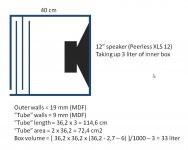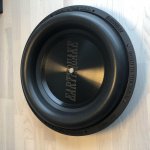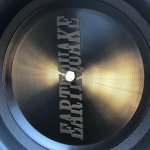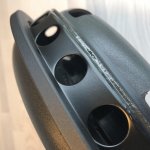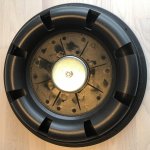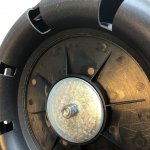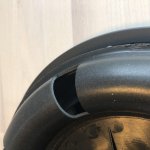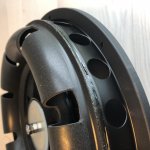Hi,
Once upon a time (like 15 years ago), I built a North Creek Thunder sub that uses XLS-12 with the 300g Mms Passive rad (830547) and a 250 Watt AB amp with a -6dB off boos around 23 hz.
The result was frightening with songs like Intergalactic by The Beastie Boys and so on. (105 dB @ 20Hz)
Some friend were even jumped out from the listening sofa (they were party people, who loved heavy basses, but they did not expected what is coming )
)
I still have a spare driver unit, but the passive rad is not available. I found the 425g and the 600g version (830548 and 549), and also the ScanSpeak Discovery 30W/0-00-00, that looks similar by the T/S
The problem is their price. (about 120-150€ these days)
I wonder if I build a 40 Liter ported box (as the application notes suggests it) Can I get the same result as the PR version delivered?
I would use almost the same cabinet that was used with the PR version, but I would place the driver on the small side.
The box would be about 34 x 34 x 71 cm outer (28 x 28 x 63 cm internal, with heavy bracing, 3 cm side walls, 5 cm front, plywood with mdf)
I calculated 1.5 liter as the driver displacement and cca 3.5 liter for the bracing plus cca 4.1 liter for the ports.
The ports would be on the front, just like the modern PA ported subs, triangle shape on the unused space, in the corners.
2 piece 8 x 8 triangle, so the surface area (64 cm2) would be the same as the 9 cm diameter suggested port (63.62 cm2), and the 51 cm length would be untouched.
Can anyone confirm if this would be also optimal?
What can I expect compared to the PR version?
Would use a Rand MA-6S power amp in bridged mode (300W into 8 ohm) and probably some HP filter to keep the subsonics away.
Once upon a time (like 15 years ago), I built a North Creek Thunder sub that uses XLS-12 with the 300g Mms Passive rad (830547) and a 250 Watt AB amp with a -6dB off boos around 23 hz.
The result was frightening with songs like Intergalactic by The Beastie Boys and so on. (105 dB @ 20Hz)
Some friend were even jumped out from the listening sofa (they were party people, who loved heavy basses, but they did not expected what is coming
I still have a spare driver unit, but the passive rad is not available. I found the 425g and the 600g version (830548 and 549), and also the ScanSpeak Discovery 30W/0-00-00, that looks similar by the T/S
The problem is their price. (about 120-150€ these days)
I wonder if I build a 40 Liter ported box (as the application notes suggests it) Can I get the same result as the PR version delivered?
I would use almost the same cabinet that was used with the PR version, but I would place the driver on the small side.
The box would be about 34 x 34 x 71 cm outer (28 x 28 x 63 cm internal, with heavy bracing, 3 cm side walls, 5 cm front, plywood with mdf)
I calculated 1.5 liter as the driver displacement and cca 3.5 liter for the bracing plus cca 4.1 liter for the ports.
The ports would be on the front, just like the modern PA ported subs, triangle shape on the unused space, in the corners.
2 piece 8 x 8 triangle, so the surface area (64 cm2) would be the same as the 9 cm diameter suggested port (63.62 cm2), and the 51 cm length would be untouched.
Can anyone confirm if this would be also optimal?
What can I expect compared to the PR version?
Would use a Rand MA-6S power amp in bridged mode (300W into 8 ohm) and probably some HP filter to keep the subsonics away.
40L tuned to 30hz looks pretty good- F3 33hz, F10 25hz
if you want it to dig a little deeper:
50L tuned to 26hz looks pretty good- F3 29hz, F10 21hz
you get a little more output in the 40-50hz range from the smaller box
ports are pretty long so probably need to put an elbow on it.
if you want it to dig a little deeper:
50L tuned to 26hz looks pretty good- F3 29hz, F10 21hz
you get a little more output in the 40-50hz range from the smaller box
ports are pretty long so probably need to put an elbow on it.
Hi madame
I run my XLS in a 33 liter vented enclosure. Needs a little lift at the lowest frequencies. It's tuned to around 23,5 Hz.
Runs os a 300 W class D amp. Works quite well.
After getting experience with Earthquake sounds products, I think I would today use a SLAPS M12 with it.
You can pick one up at discount price, for less than 100 Euro. I think this is hard to beat.
I run my XLS in a 33 liter vented enclosure. Needs a little lift at the lowest frequencies. It's tuned to around 23,5 Hz.
Runs os a 300 W class D amp. Works quite well.
After getting experience with Earthquake sounds products, I think I would today use a SLAPS M12 with it.
You can pick one up at discount price, for less than 100 Euro. I think this is hard to beat.
Attachments
Earthquake Sound
77 Euro
But for sure a vented version with the same parameters will work as well. Difference is the extra volume needed for the port.
Downside of the pR version will be a tendency to vibrate/rock at the loudest volume, bue to the large mass of the PR being shifted .... but you must have the same issue with you current PR implementation of course.
77 Euro
But for sure a vented version with the same parameters will work as well. Difference is the extra volume needed for the port.
Downside of the pR version will be a tendency to vibrate/rock at the loudest volume, bue to the large mass of the PR being shifted .... but you must have the same issue with you current PR implementation of course.
The ports would be on the front, just like the modern PA ported subs, triangle shape on the unused space, in the corners.
2 piece 8 x 8 triangle, so the surface area (64 cm2) would be the same as the 9 cm diameter suggested port (63.62 cm2), and the 51 cm length would be untouched.
Triangle shaped vents like that are the worst type of vents to use for subwoofer duty. Lossy, and could be prone to chuffing. I'd recommend against using that approach.
Here is some testing done in regards to port shape.
Loudspeaker Port Nonlinearity.pdf - Google Drive
Loudspeaker Port Nonlinearity.pdf - Google Drive
Hi Mordakai
Very nice document and test
From this, it is also easy to see thet my serpentine slotport with a lot of sharp 180 turns, is not ideal at all.
Makes me even more sure that for small boxes with low tuning (say >30 liter, >30Hz) the only real way to go is with a passive radiator.
A passive radiator is of course not ideal either, but I think it would show both less compression and THD than a port.
Think I have to order a SLAPS M12 for my XLS12 and rebuild it .... when I get time
/Baldin
Very nice document and test

From this, it is also easy to see thet my serpentine slotport with a lot of sharp 180 turns, is not ideal at all.
Makes me even more sure that for small boxes with low tuning (say >30 liter, >30Hz) the only real way to go is with a passive radiator.
A passive radiator is of course not ideal either, but I think it would show both less compression and THD than a port.
Think I have to order a SLAPS M12 for my XLS12 and rebuild it .... when I get time
/Baldin
Thanks for the reactions.
It will be a hard decision: Form vs function.
I guess the function is way more important....
I still got no idea what to expect from the ported version compared to the 830547 (300g Mms) PR version sub I had looong before.
the 105dB at 20 Hz was shocking for sure form the North Creek Thunder sub. If we count it was capable to reach it with only 250w amp...... even more stunning
It will be a hard decision: Form vs function.
I guess the function is way more important....
I still got no idea what to expect from the ported version compared to the 830547 (300g Mms) PR version sub I had looong before.
the 105dB at 20 Hz was shocking for sure form the North Creek Thunder sub. If we count it was capable to reach it with only 250w amp...... even more stunning
SLAPS M12 arrived
Just to give an impression of the build quality of the SLAPS M12, are here some pictures.
The diaphragm is made of hard plastic. chassis (if you can call it that for this unit) is made of steel plate with a rubber gasket.
The surround is quite tough rubber/foam.
Overall I think the quality is quite good, and all seems quite sturdy.
Just to give an impression of the build quality of the SLAPS M12, are here some pictures.
The diaphragm is made of hard plastic. chassis (if you can call it that for this unit) is made of steel plate with a rubber gasket.
The surround is quite tough rubber/foam.
Overall I think the quality is quite good, and all seems quite sturdy.
Attachments
SLAPS M12
Fs 25.5Hz a bit high
Qms 7 a bit low
xmax 100mm hard to believe (one way or p-to-p??)
If I check the xls 830547 PR
Fs 12.6Hz
Qms 12.6
Xmax 24 mm
Or the ScanSpeak Voyager w30-0-0 PR
Fs 9.5Hz
Qms 14
Xmax 28mm
It is hard to decide.... PLS let me know how is it works and what speaker you use it with
Fs 25.5Hz a bit high
Qms 7 a bit low
xmax 100mm hard to believe (one way or p-to-p??)
If I check the xls 830547 PR
Fs 12.6Hz
Qms 12.6
Xmax 24 mm
Or the ScanSpeak Voyager w30-0-0 PR
Fs 9.5Hz
Qms 14
Xmax 28mm
It is hard to decide.... PLS let me know how is it works and what speaker you use it with
Last edited:
Just to give an impression of the build quality.........
O ooh!
GM
It is a p-p measurement for the SLAPS stuff. This means you only need to use one SLAPS per XLS driver as it has the volume displacement required for proper operation.
Usually you need a PR to have twice the VD of the sub on its own (if you want to hit max SPL possible). With an XLS driver this requires two of the matching PRs.
The SLAPS are quite economical when looked at in that way.
Usually you need a PR to have twice the VD of the sub on its own (if you want to hit max SPL possible). With an XLS driver this requires two of the matching PRs.
The SLAPS are quite economical when looked at in that way.
SLAPS M12
Fs 25.5Hz a bit high
Qms 7 a bit low
xmax 100mm hard to believe (one way or p-to-p??)
If I check the xls 830547 PR
The Fs of the device is directly related to the mass of the diaphragm. You lower it by adding extra mass. Listing a PRs resonance frequency is bit odd. They don't really have one, they have one as part of a tuned system.
I mean yeah it'll resonate at a given frequency when in free air but that's not important. You add the amount of mass required to tune it to the frequency you desire in the cabinet volume you have.
There are some instances where the PRs natural mass is too high for a standard tuning. I ran into this issue with the Dayton Audio DMA series. Whatever I did I could not make the matching passive radiators work satisfactorily with their drivers of the same line. I contacted them and asked if the mass listed in the datasheet was with or without the pictured wing-nut and washers. It was without, so no way to lower the mass further. This was quite disappointing.
Interesting - I ran into the same issue with the PRs for the Dayton DSA series. The built-in mass is a bit high, so Fb is lower than I'd like it to be in my build. Only way to fix that is to use two of the PRs, LOL.
Oh, and yes, Fp, the free-air resonance of the PR, is important. The combined FR will show a notch in the output at Fp.
Oh, and yes, Fp, the free-air resonance of the PR, is important. The combined FR will show a notch in the output at Fp.
- Status
- This old topic is closed. If you want to reopen this topic, contact a moderator using the "Report Post" button.
- Home
- Loudspeakers
- Subwoofers
- Peerless XLS-12 (830500) ported vs passive radiator config
